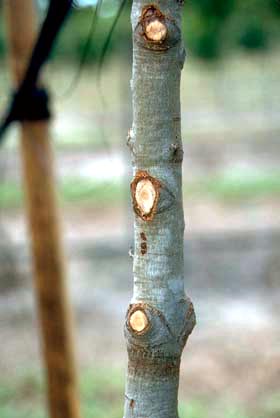If your anything like me you’ve been anxious to get out in the garden and get you hands in the soil. While it is still a bit to early for many garden chores, this is a great time to get out and prune your trees.
Lightly pruning trees can be done at any time of the year, but any major shaping or structural pruning is best done in March and April when the trees are still dormant. There are many benefits to pruning your trees regularly. A well pruned tree is stronger, and healthier. While trees can be pruned to maintain a natural look, a tree that is pruned regularly has a greater aesthetic value, and of coarse pruning helps control the size of the tree.
Here are some basic tips for pruning your ornamental or fruit trees this Spring;
-
- Trim dead and broken branches back to a side branch or trunk.
- Remove diseased branches or diseased branch parts.
- Remove watersprouts. Watersprouts are fast growing shoots that grow straight up from the branch. They rarely branch or flower. Unpruned watersprouts destroy the form of the tree and make spraying more difficult. Wait to remove watersprouts until May, June, or July. Spring pruning of watersprouts may stimulate regrowth.
- Remove suckers. Suckers are sprouts coming from the roots or lower trunk at or below the ground line. Like watersprouts, suckers should be trimmed out during summer.
- Prune out crossing or conflicting branches. Choose the least desirable or smallest branch to remove.
- Look for crotch angles between branches that are less than 40 degrees. Cut one of the branches out. Wide crotch angles of 40-90 degrees are structurally stronger so the branch holds more fruit weight.
- Trim out slow growing, weak, or non-productive branches.
- Prune back low growing branches or parts that touch the ground.
- When deciding on which major branches to keep, select ones growing away from the prevailing winds. When in leaf, branches pointed into the wind tend to be blown back toward the tree, therefore distorting the growth.
- In the first five years of your tree’s life, prune only enough to correctly shape the tree.
Make sure that your cuts are made back to the branch collar. Do not leave stubs on your tree. Not only are they unsightly, but they are not healthy for the trees. Look at this simple diagram bellow by Alex Shigo to under stand a properly made pruning cut. Be careful not to tear the bark down the trunk while making larger cuts with a hand saw.

One additional note about tree pruning. When it comes to pruning larger trees, please call a professional arborist. Tree climbing can be very dangerous and should be left to a trained professional.
Please, stay off the ladders if you are going to use a chain saw.




